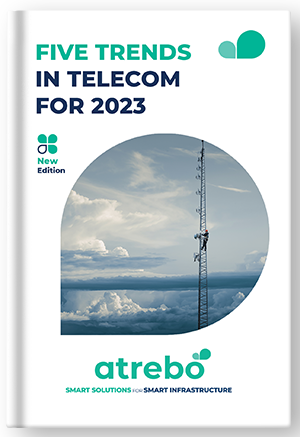Did you know telecommunications is one of the most dynamic and fastest-growing industries in the world? In recent years, the bulk of its revenue came from Europe, North America, and Asia-Pacific, accounting for 70% of the total. In this article, we will get into the five trends in telecom for 2023 shaping this industry.
After two long years of global crisis, the telco ecosystem has again taken off and it certainly shows. The ever-growing importance of 5G, the Metaverse, the impact of broadband technology expansion worldwide, Big Data, Blockchain, and IoT and Asset Monitoring all together are changing the world as we know it.
This situation has led to a highly competitive market environment where innovation is critical to surviving for Telcos, Towercos, and Fibercos. In addition, worldwide IT spending is projected to reach a total of $4.6 trillion in 2023, an increase of 5.1% from 2022, according to the latest forecast by Gartner, Inc.
The massive fiber deployment the market experienced last year is still taking place today and experts have predicted that by 2030 the value of the global 5G infrastructure market will reach $131.4 billion.
Even we expect 5G connectivity to be fully developed via Satellite. Could you believe it? If you’d like to know more, keep reading. Now, it’s time to explore the top five trends in telecom for 2023!
5 trends in the telecom industry that will drive innovation for telcos
1. The metaverse and 5G connectivity
Let’s talk about the most discussed trends in the telecom industry that will be a milestone in 2023: the Metaverse and 5G.
As you may know, the term “Metaverse” has taken all over the Internet. But… how does it create value for the telecom ecosystem? This term was first introduced in the science fiction novel Snow Crash (1992) written by Neal Stephenson to show how humans interacted with each other in a 3D virtual space, using a metaphor of the real world.
It seems like it was ahead of its time, isn’t it?
Nowadays, Communications Service Providers (CSPs) are struggling to adopt this telecom trend for 2023 and they point out it’s because there’s still a lot of work to be done to make it work at a higher scale.
For this matter, Telcos are already joining the metaverse not only as participants but also as cocreators of this post-reality universe to deeply develop 2023 emerging technologies and take advantage of such potential opportunities.

However, replacing our reality with a digitally virtual world requires strong 5G optimization, cloud computing, and low latency, among others, which is translated into a big investment.
What are the benefits for infrastructure management companies of integrating the metaverse into their business?
Well, there are many ways in which this telecom trend for 2023 will revolutionize the industry as a whole in the upcoming years, specifically for Telcos and Towercos:
- Development of human interface hardware with AR and VR
- Establishing lead connectivity providers
- Edge and AI computing capabilities
- Advanced analytics and AI to boost revenues
- Cybersecurity of data
- Own metaverse platforms
- Engagement in the metaverse ecosystem for collaboration opportunities
As you might expect, it is a fact that 5G is a critical enabler for the metaverse to exist and other technologies such as Blockchain, Web 3.0, Non-fungible tokens (NFTs), Digital Twins, or Artificial Intelligence are booting its early development.
Now that we are aware of the full potential of the Metaverse, let’s step into the blockchain as one of the top five trends in telecom for 2023.
2. Blockchain and smart contracts
Approaching Blockchain as a disruptive technology is a wise move as it will be a game changer for the telecom industry in 2023. It simplifies daily operations through a digitally distributed and decentralized ledger across a network.
Blockchain still trending after all these years, transforming telecom sectors by reducing the role of intermediaries, automating the SLA agreements, reducing fraud, and achieving higher cost savings.
Indeed, previous forecasts point out that global blockchain technology revenues will experience massive growth in the coming years, with the market expected to climb to over $39 billion in size by 2025, according to Statista Research Development.
The global spending on blockchain solutions is expected to raise by 235% and reach $14.4 billion by 2023.
Communication Service Providers (CSPs) will see the greatest impact in the evolution of this value chain into their core management systems and services, providing opportunities for cost reduction through process efficiency gains and revenue growth through new value propositions.
Blockchain in 2023: trends transforming the telecom industry
- Decentralized finance and banking: blockchain instruments used mainly in the finance and banking sector to work with smart contracts making it possible for two parties to work without any intermediary ensuring transparency and security of information.
- International trade: issuance of custom invoices, certificates, licenses, and other documents is possible thanks to smart contracts which reduce operational times to carry out these tasks and improve efficiency.
- Cryptocurrencies: no doubt it is the most known method of using blockchain to create digital assets and online payment systems.
- Value chains: the control of goods and automation of control of regulations to ensure reliability and improve efficiency, reducing costs. It creates new operating models.
As you might expect, decentralization leads to new business models, providing a strong competitive advantage. It is used either in transactions or communications.
In addition, smart contracts are possible thanks to Blockchain. It provides the possibility to remove the need for supervisory oversight, leading to automation of processes.
In Atrebo, automation of processes is at our core business and that’s why we have partnered with Telefónica Tech to digitalize 200,000 telecom infrastructures with Blockchain using TrustOS and TREE platforms. Read the full use case and find out how to carry out the tokenization of inventory assets with blockchain to reduce operating costs.
“TREE platform allows to perform a tokenization process of an asset and easily certify the audits of contracts, using a generated QR security code available in TrustOS”.
3. Machine learning and data analytics for network operations
With customers demanding high-performance quality products and services, network operations optimisation becomes critical for CSPs. Indeed, applying Machine Learning (ML) algorithms in telecommunications results in cost reductions and higher profit margins.
The inclusion of AI in telecom is shaping the future. Together with the emergence of 5G and edge applications, not to mention the potential of the metaverse will increase this need for high-performance technology to fully meet customers’ expectations.
But how do telecom companies use Machine Learning to boost their profits?
AI and predictive analysis for optimising global telecom networks
Integrating ML implies turning from infrastructure-driven operations to a data-driven approach, which seems to be the future and right path to take nowadays.
This branch of AI and advanced computer science brings models which effectively classify, prioritize and escalate incidents through predictions to instantly take corrective actions. Alongside this, deep learning – also known as a Machine Learning technique – makes data to be even more accurate.
- Consistent network quality
- Performance monitoring and detection of anomalies
- Take corrective actions (predictive and preventive maintenance)
- Make better decisions on allocating resources

Furthermore, Atrebo develops Telco Site Rental Savings, a Celonis’ Execution App for massive rental optimisation processes for MNOs and TowerCos. It is currently managing up to 250,000 telco towers and other mission-critical infrastructure in different countries around the world.
To conclude, it’s no wonder that embracing predictive analytics is the way forward to optimize Telco’s operations. Read on to the end to learn more about the 5 trends in telecom for 2023.
4. 5G satellite access connectivity
You may have noticed how popular is the term “5G” nowadays. One of the newest 5 trends in telecom for 2023 is the 5G satellite access connectivity. At this point, you might be wondering what this is all about. Let’s start.
For a long time, satellite communication has remained independent of mobile networking. Now, with the introduction of the new generation of satellites, it is possible to integrate networks to manage connectivity to cars, airplanes, vessels, and other IoT devices.
The great capability of reaching 5G in remote and rural areas is driving forward its early development.
Therefore, this year we expect a boom in satellite access for Non-Terrestrial Networks (NTNs). This is undoubtedly an unprecedented innovation that will usher in a new era of connectivity.
5G Satellite access connectivity is possible thanks to LEO Satellites (Low Earth Orbit) which operate between 500 and 2000 km above the earth’s surface. It reduces latency, improving the reception and transmission of data and of course ensuring communication signals to remote places.
The expansion of fibre deployment we talked about in telecom trends 2022 is now reaching a higher level with this new technology as it extends 5G networks to air, sea, and areas not covered before. But what is this all about? SMART CITIES.
5. Tower Carve-Outs
In recent years, the number of infrastructure subsidiaries have considerably increased in the market. MNOs (Mobile Network Operators) do not only focus on the quality or performance of their network operations as a part of their strategy, but also on divesting their portfolio of towers to capitalize their liabilities.
This is a smart decision to obtain a higher percentage of market share while reducing debt and staying competitive. But what other reasons lies ahead of this divesting strategy?
First of all, the main reason is financial as explained above, they intend to increase their profit margins by reducing CAPEX and optimising the return on investment (ROI).
Secondly, there’s a purely strategic reason which basically focus on optimising OPEX using pooling, meaning that they “merger” to limit competition.
According to a Telecom Review article by Sofrecom, over the past 10 years in Europe, large independent Towercos have spent nearly 30bn€ to buy 100k towers from MNOs.
For example, just a few days ago Helios Towers announced that it has completed the acquisitions of Omantel’s passive infrastructure assets in Oman, adding 2,519 sites to its portfolio for $495 million. Also, in a recent report provided by TowerXchange, we could see that Spark and Vodafone announced plans for tower carve-outs in New Zealand.
In short, many MNOs are preparing for a potential carve-out to extract the best value from their infrastructure and increase profit margins. A great strategy to unlock and maximize value for shareholders.
Then, this strategy is one of the main telecom industry trends for 2023 for MNOs and Towercos, and we are pretty sure that it will stay for a long time. In fact, business carve-outs provide leaders with a way to accelerate digital adoption and transformation by automating tower operational processes.

Closing Remarks
To wrap up, technology is evolving so fast that is forcing telecom infrastructure companies to optimise their operations and automate their activities using AI, VR, ML, Blockchain, and other emerging technologies, delving into disruptive innovation decisions to survive in the market.
The Metaverse itself is combining these technologies to bring the Internet to life. A great opportunity for operators to establish a competitive advantage, work on upgrading current 5G networks and adapt to the upcoming arrival of 6G, expected by 2030.
In addition, according to research, the global telecom services market is expected to grow at a CAGR of 5.4%, reaching $2,467.01 billion by 2028.
It is a fact that the rapid spread of digitalisation worldwide, preferences towards 5G and cloud-based technology as well as the demand for high-speed data connectivity will increase the spending on wireless communication.
Furthermore, the future of telecommunications will require operators to look beyond connectivity, and complexity issues and stand for new growth opportunities to offer end-to-end disruptive solutions.
We are looking forward to knowing what this brand-new reality has in store for us.
The age of automation of telco infrastructures
Telcos today, constantly develop new business models in which agility and flexibility to changes are critical to success. Seeking to resist to the intense competition pressure while reducing operating costs seems a hard task to achieve.



